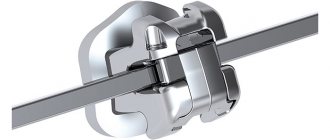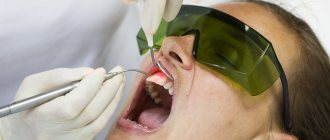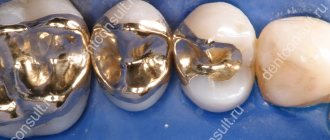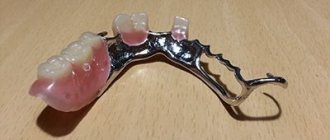Patients with malocclusion, crooked or crowded teeth are usually prescribed orthodontic treatment, during which the person will wear special structures on their teeth - braces. Before starting treatment, the doctor may offer the patient several options for braces, including ceramic braces. What is good about this option, what advantages do ceramic braces have, how are they installed? The material we have prepared will help you find the answer to all these questions.
Let's start the article by telling you what is special about ceramic braces and why patients most often choose such systems.
White wire braces: myths and facts
Many dental fields are surrounded by myths and misconceptions, and white braces are no exception. So, there is a myth that the arc is cast from light-colored metal. In fact, alloys of nickel, steel, titanium, etc. are used for this, and the light shade is obtained through the use of Teflon. It is quite resistant to external influences, although it can peel off due to such irritants. Another thing is that the frequency of changing arches, which is from 1 to 3 months, will not allow Teflon to lose its qualities, of course, provided that proper care of the system and oral hygiene is taken care of.
White braces cannot be called completely invisible; they will still stand out against the background of the dentition, but they are much less noticeable than metal ones. It is worth saying that a certain percentage of patients, on the contrary, consider it stylish and are happy to give preference to metal structures.
Ceramic braces: pros and cons
Any type of braces has its advantages and disadvantages; ceramic braces are no exception in this regard - they have both pros and cons, which are important to study in detail before you make your final choice in favor of this type of orthodontic appliance.
The main advantages of ceramic braces
Orthodontists consider the following features of ceramic braces to be advantages of the systems:
- High level of aesthetics. Ceramic plates of braces after installation merge with the natural color of the teeth;
- In the manufacture of ceramic braces, modern, reliable and hypoallergenic materials are used, so when installing them, the risks of allergic reactions and negative side effects are eliminated;
- Ceramic braces are comfortable during everyday use. The power arc of ceramic brace systems exerts soft, gentle pressure on the teeth, so the displacement of dental units in the rows occurs smoothly, without causing severe pain and discomfort;
- The risk of injury to the oral mucosa is reduced, since ceramic braces have a perfectly polished surface, without sharp corners;
- The plates of ceramic braces exactly follow the shape of the tooth surface, and such anatomical accuracy ensures strong adhesion of the plates to the tooth surfaces.
Having considered the key advantages of ceramic braces, let's find out what features of ceramic braces can be called their disadvantages.
Cons of ceramic braces
If you read reviews about ceramic braces, you can note that their main disadvantage is the high price: the cost of ceramic braces will be 2-3 times higher than the price of metal structures. Also, the disadvantages of ceramic brace systems include:
- Risks of breakage and chipping on ceramic plates of braces. Ceramics is a durable material, but it is very vulnerable to increased loads. If, after installing ceramic braces, you do not follow the doctor’s recommendations, this may lead to their breakage;
- Not all manufacturers use high-quality ceramics for the manufacture of braces, which are capable of not staining from contact with pigments from drinks and food. This can lead to staining of the plates and then ceramic braces will lose their aesthetics. In dentistry - "Firadent" patients are offered ceramic braces from the world's leading brands, and therefore we guarantee that your smile will remain attractive throughout the entire course of bite treatment!
- The ceramic plates of braces can come off, but this only happens if the doctor makes mistakes when installing braces and fixing them on dental surfaces. At Firadent, protocols for the preparation and installation of braces are strictly followed, and high-quality and reliable materials are used to fix the ceramic plates;
- The period of bite correction with ceramic braces will be longer, which is explained by the fact that strong tension cannot be applied to the arch in ceramic bracket systems, since strong pressure will lead to breakage of the ceramic plates.
You also need to take into account the fact that ceramic braces may not be suitable for you: if the diagnosis reveals a complex malocclusion, then it is more effective to treat it with metal braces. The reason is the same impossibility of creating strong pressure, which is necessary to eliminate complex malocclusions.
The final decision on the type of braces that will be used to correct the bite is always made together with the orthodontist. Only a specialist will be able to tell you which braces - ceramic or metal - will be effective in your case, but of course, when offering you different options for systems, the orthodontist will also take into account your wishes regarding aesthetics, treatment time, and price of braces.
There are a lot of questions on the Internet about ceramic braces. Most often, people planning to correct their bite with braces are interested in why ceramic braces are better than metal ones or how ceramic braces differ from sapphire braces. We will give you clear and honest answers to these questions below.
White arches, clasps and elastic bands
For most people, braces are associated only with bulky, monstrous structures, and many are not even aware of the existence of white braces. They can be made of plastic, sapphire or ceramic, and their main difference will be aesthetics, that is, they are practically invisible in the mouth and do not cause any psychological discomfort to the patient.
White braces do not have a specific name; they are usually called simply white arches, since they become the main component of the entire structure. Its elastic bands and clasps are also usually white, therefore, in addition to the traditional task of straightening teeth, using this system you can also hide the fact of wearing braces from prying eyes.
Initially, they were made of plastic and differ favorably from metal structures precisely because of their aesthetics, but the downside was their fragility and low strength. Over time, the paint on the system wore off, chips appeared and the color changed, so ceramic and sapphire designs also began to appear, replacing plastic ones.
White braces elements
Not all patients know about the possibility of installing any other braces other than metal ones. Meanwhile, the attending physician may suggest other product options. In addition to standard metal structures, the patient can install devices from:
- plastic,
- ceramics,
- artificial sapphire.
Standard devices are not very attractive, which makes patients self-conscious about their appearance. Modern orthodontics has developed new designs that make it possible to give a person a more aesthetic appearance and make them invisible. Aesthetic braces are almost invisible, which facilitates faster adaptation to the system and promotes psychological comfort.
Despite the lack of an official other name, patients call such structures white arches, the main elements of the product. As in classic models, the purpose of transparent braces or white devices is the same - to correct the bite, improve the smile and straighten the teeth. The remaining structural elements (locks, plates) are also made in white. Many patients find such products more visually attractive, since the systems are almost invisible against the background of the teeth.
However, such systems do have drawbacks. The use of such structures requires regular visits to the doctor, since the paint applied to the surface of the arc can wear out and get dirty over time , and it will not be possible to paint it yourself and return the original color to the product.
Disadvantages of white braces
As for the shortcomings, there are also them, which is quite natural; speaking specifically, these should include:
- an attractive appearance is possible only on white teeth;
- longer period of adaptation of the patient to the system due to its size;
- in comparison with metal structures, they are less reliable in terms of strength;
- they are more demanding to care for in terms of their fragility.
One of the most significant arguments “against” white systems is their price; for a considerable number of patients this aspect is of decisive importance.
Peculiarities
Ceramic fixed devices are ligature, i.e. in them, the arc is attached to the locks with rubber rings that are self-ligating. The second type of braces is equipped with a built-in retainer that holds the arch in the grooves. Ligature-free systems are more expensive, but have their advantages. For example, the absence of wings and hooks makes the locks smoother, smaller and less traumatic for the delicate mucous tissues of the oral cavity. In addition, in self-ligating structures, the friction between the bracket and the arch is several times less than in ligature devices, which reduces the feeling of discomfort and shortens the treatment time by several months.
The main advantage of ceramic braces is the ability to paint the lock in the desired color; they will suit teeth with any shade of enamel. In addition, ceramic locks are not subject to oxidation.
What types of white braces are there?
Today, plastic structures are not found very often, giving way to ceramics and sapphires. Ceramic systems are found in two versions: monocrystalline and polycrystalline. The former have a matte tint, while the latter almost completely merge with the teeth due to their transparency. With their help, you can set and successfully solve the problem of correcting the bite, as well as get rid of the patient’s psychological problems.
Ceramic products - the golden mean
Another good thing about ceramics is that you can eat your favorite food almost without exception, and also not have to worry about poor diction. The disadvantage will be the need for careful maintenance, but this is perhaps the only serious disadvantage of such structures.
Often ceramic systems are produced with a white arc. They adhere well to the enamel, are transparent and almost invisible, but the price for them starts at about 50 thousand rubles.
You can find out more about ceramic braces here.
Sapphire designs - elite option
Sapphire systems are made from artificial crystals specially grown for this purpose. They are distinguished by a high level of strength, look very beautiful and are almost invisible to others, but are significantly more expensive than ceramic systems.
Note: It is best to place white braces on the upper row of teeth, since they are more noticeable when talking and smiling. To achieve an even higher level of aesthetics, many dentists recommend installing systems with wings that will protect the structure from food particles getting into it.
The duration of treatment with sapphire systems is about two years; in other respects there are no differences from ceramics, but this does not concern the cost. The difference between sapphires and ceramics is approximately twofold; the price for such designs can reach 100 thousand.
Full information about sapphire white braces can be found here.
Plastic systems - a budget solution
There are no external differences between plastic braces and ceramic or sapphire analogues; it is easy to choose the color to match the desired shade; in addition, you can further improve aesthetic indicators with the help of a white arch. Finally, the financial aspect plays a decisive role, since this is the cheapest option of all those discussed above, but there are also disadvantages that push many people to choose sapphire or ceramic designs:
- not the highest strength, which, of course, can be strengthened with additional materials, but this will immediately lead to an increase in the cost of the system;
- poor color fastness, which means avoiding some products, especially those containing dyes;
- longer duration of treatment due to slow movement of teeth in a row.
You can find out more about plastic white systems in this article.
Price of braces
The price of braces is significantly influenced by the material from which the systems are made, as well as their technical characteristics. The most expensive among white braces will be sapphire models. Classic metal braces are the most affordable. However, they are not made with a white arc, since such a combination will not improve the aesthetics of the structure. An alternative to braces are custom-made removable aligners. The main advantage of the models is their invisibility and the ability to remove them for preventive measures. However, the cost of this type of orthodontic treatment will be even higher. In addition, in severe cases, aligners may not be effective enough.
Having decided to seek orthodontic treatment, you need to trust a specialist who will study the situation and associated factors and determine the most preferable correction method. Butorina Irina Aleksandrovna is a highly qualified orthodontist with extensive experience. By turning to her to correct a malocclusion, you are guaranteed to get the desired result.
Differences between white arcs and metal ones
The arch is the part of the orthodontic structure that receives the closest attention. This state of affairs is explained by the fact that its role in correcting the bite cannot be overestimated; in particular, it is the arch that creates the necessary pressure, due to which the teeth move in the desired direction.
From the point of view of its characteristics, a white arc is no different from a metal one; the main role here is played by external differences. In fact, it is also made of metal, but covered on top with enamel with a special composition, thanks to which it is not so striking to others. Color does not have any effect on the effectiveness of the treatment process.
Ligature braces
The arch in the ligature bracket system is held in the grooves using metal elements made of a medical alloy or silicone rubber bands. They control the degree of tension in the archwire and influence the speed at which teeth are straightened. Ligatures stretch over time, lose their force, or break, so the patient must regularly visit the orthodontist to replace the metal elements.
If the assistive devices are made of elastic material, a person can learn to change them without the help of a doctor. These include classic metal devices, often installed in childhood, when teeth and jaw bones are much easier to correct.
Features of wearing and care of the system
White braces can be an excellent solution for those who may have psychological discomfort from wearing such braces. For example, many children experience stress from ordinary metal structures because they are teased by their peers, and to make it easier to endure this period, it makes sense to consider installing just such a structure.
Some patients complain that the white color changes to yellow over time, blaming the imperfection of the design and their dentist for this. However, the fact is that such a picture arises in situations where patients do not take good care of their oral hygiene and skip visits to the doctor for correction. Accordingly, a proper attitude to these issues will allow you not to encounter this problem while wearing the system.
Ligature and non-ligature ceramic braces: what to choose?
Modern brace systems are classified into different types not only according to the material of manufacture, but also according to the method of fastening. For this reason, ceramic braces can be either ligature or non-ligature (self-ligating). Which type is better?
Ligature
The classic version of braces, consisting of an arch to which clasps are attached.
The clasps on the arch are secured with small rings and these are ligatures. Ligatures can be in the form of elastic bands or wires. Ceramic braces with elastic ligatures are used to treat minor malocclusions, at the very beginning of the course of treatment, or to correct the position of individual units in the dentition, since this type of ligature creates a slight pressure. Ligatures in the form of wires firmly fix the arch and are used to correct serious malocclusions and at the final stages of treatment. Ligature ceramic braces have some disadvantages: designs with wire ligatures can scratch and damage sensitive tissues of the oral cavity, and rubber ligatures can quickly stretch and then they will need to be replaced. However, ligature ceramic braces will have a more affordable price compared to non-ligature systems.
Self-ligating
Such bracket systems are a definite innovation in dentistry.
They have a special type of design in which the locks are attached to the arch of the braces not with rings or wires, but with special fasteners in the form of fixing clips. The big advantage of self-ligating ceramic braces is that you won't need to visit the orthodontist's office too often for system adjustments. In addition, this design is less massive, and therefore more comfortable to wear. The only disadvantage of self-ligating ceramic braces is their high cost. So which braces are best? It is important to note that bite correction is successfully performed by both self-ligating and ligature ceramic braces, and therefore it would be best for the patient to consult an orthodontist and find out which option would be optimal in his case.
Which white braces should you choose?
Today there are many different models on the market, but the most common and popular are:
- Clarity - durable and reliable braces with a matte finish, the base is a metal groove;
- Mystique GAC - made entirely of ceramic without any metal inserts;
- Reflections is a ligature ceramic system, a distinctive feature is the high effectiveness of treatment;
- Damon clear - has a small size, and most importantly, is one of the lingual systems; the manufacturing material is ceramics;
- LUXI II Keramik - a design with high efficiency indicators, characterized by the use of gold plating for the grooves;
- In Ovation is a lingual system characterized by excellent reliability of fixation on the patient’s teeth;
- QuicKlear is another option that offers excellent and secure hold, which is achieved through the use of special protrusions in the hook-shaped design.
How are ceramic braces installed?
The process of installing ceramic braces is divided into several successive stages and always begins with diagnostics, during which not only a visual examination of the patient’s oral cavity and teeth is carried out, but also a panoramic image of the jaw is taken, and less often a CT scan.
Based on the image, a treatment plan is modeled using specialized computer programs, and each of its stages can be visualized. In our clinic in Moscow - “Firadent”, we show and tell patients about each of the stages of bite correction with ceramic braces, and also demonstrate the future result of treatment. The opportunity to see how your smile will change after a course of correction with ceramic braces is an excellent motivation for starting orthodontic treatment and an opportunity to dispel the patient’s vain fears and prejudices about braces!
Next, preparations are carried out for the installation of ceramic braces, which may include the following activities:
- Treatment of caries, gum inflammation;
- Removal of teeth to provide space for the displacement of other teeth in the row;
- Professional oral hygiene.
After all the necessary preparatory procedures are completed, an impression is taken from the teeth, according to which ceramic braces will be made. When the design is completed, you will be invited to install a ceramic-bracket system at the clinic.
The process of installing ceramic braces is a procedure that takes 1.5-2 hours and does not cause any discomfort to the patient. When installing ceramic braces, the orthodontist performs the following steps:
1. Treats the surface of the teeth with a special solution that creates micropores on the tooth enamel that improve the quality of adhesion.
2. Wash the solution off the teeth, dry it and treat it with a bond, and then apply an adhesive composition to the ceramic plates of the braces (on the back side).
3.The plates are fixed on the tooth and after that the doctor will “shine” them with a lamp so that the glue hardens and the braces are held firmly.
After installing ceramic braces on each tooth, the doctor will place and secure a power arch with locks or ligatures.
THIS IS USEFUL TO KNOW: People often wonder whether it is possible to put ceramic braces on only one jaw. No, in most cases, malocclusion treatment requires the installation of ceramic braces on two jaws. But if you want to save on orthodontic treatment, you can put combined braces - ceramic on the upper jaw, metal - on the teeth of the lower jaw. The teeth of the lower jaw are less noticeable when talking and smiling, so here, if desired, you can sacrifice a little aesthetics in favor of economy.
Note that the installation of ceramic braces (and any others too) on the upper and lower jaws is carried out in two visits to the orthodontist. First, ceramic braces are placed on the upper jaw and after about two weeks, braces are installed on the lower jaw.
Cost of installing white braces
The price is largely determined by the model of a particular system. For example, lingual systems will cost significantly more than ligature ones, but you will have to visit the dentist for correction, and, accordingly, you will have to pay for it less often (once a month versus three).
Factors such as the complexity of the treatment, the current state of health of the patient, the level of oral hygiene, and so on also play a role in pricing. It is worth remembering that before installing the system, it is necessary to cure all dental diseases, possibly removing wisdom teeth.
The approximate cost is calculated as follows:
- consultation and diagnostics - from 1,000 to 2,500 rubles (in some clinics the initial consultation is free);
- installation of a bracket system - from 100 to 150 thousand (for both jaws);
- design correction - about 1 thousand per visit;
- removing braces, cleaning teeth, installing retainers - approximately 5-6 thousand.
Caring for a ceramic bracket system
Hygienic care of braces and teeth during treatment is quite difficult. Therefore, the patient must be prepared to comply with the following rules:
- clean the oral cavity and equipment using V-shaped orthodontic brushes, special brushes, floss, and irrigator;
- Perform hygiene procedures at least 2 times a day, and after eating, rinse your mouth thoroughly. Once every 3-4 months you should resort to professional cleaning in the clinic;
- adhere to a special diet: foods and drinks should not contain strong coloring pigments. You should not eat very hot or cold food, as this contributes to the formation of microcracks in the braces;
- refrain from smoking;
- do not eat sticky substances (for example, toffee, dried apricots, etc.), do not chew nuts.
Reviews
Tatyana, 28 years old
I installed a structure made of sapphires. I was pleased with both the result and the wearing procedure itself. What pleased me most was the fact that although the design is noticeable on the teeth, it looks quite cute and stylish.
Galina, 30 years old
I opted for a ceramic system, but soon realized that it was better to give preference to a sapphire one. The main problem was that the structure became quite dirty and it was simply impossible to wash off traces of dyes.
Victoria, 23 years old
I installed plastic braces despite the admonitions of my doctor and regretted it - they quickly became unusable, looked terrible and eventually broke. Now I’ve listened to the advice and decided on ceramics. The downside is that I have to limit myself in taking certain products, but I don’t even remember the danger of breakage.
Metal and ceramic braces: the difference
The main difference between ceramic and metal braces is that different materials are used to make the plates that are attached to the tooth surfaces. For the manufacture of metal braces, metal alloys are used - titanium, cobalt-chrome.
Metal is characterized by much higher strength and resistance to strong and constant loads, so metal braces are reliable, the arch in their design can be set to maximum tension, and this allows the use of metal braces for the effective correction of complex malocclusions. But metal braces are significantly inferior to ceramic braces in terms of aesthetics.
The question of which braces are better - ceramic or metal - is best asked to the orthodontists of our clinic in Moscow - “Firadent”!
Comparison of different systems
To understand which braces are better and how they differ, let's look at the following table.
| Types of braces systems: | Ceramic | Sapphire | Metal |
| Anomaly complexity | The aesthetic system copes with minor anomalies. | The aesthetic system copes with minor anomalies. | Coping with any anomalies. |
| Duration of treatment | Longer in terms of teeth straightening, 2-3 months longer to wear than metal ones. | The treatment period is not inferior to metal ones. | Fast in treatment due to a firmly controlled arc. |
| Aesthetics | Ceramics are matched to the color of the enamel. | Transparent, white-coated arcs, almost invisible when smiling and talking. | Not aesthetically pleasing, clearly visible on the teeth. |
| Price | Average in cost. | The most expensive. | Available for all patients. |











